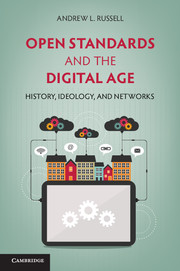Book contents
- Frontmatter
- Dedication
- Contents
- Tables and Figures
- Acknowledgments
- List of acronyms
- 1 Introduction
- 2 Ideological Origins of Open Standards I: Telegraph and Engineering Standards, 1860s–1900s
- 3 Ideological Origins of Open Standards II: American Standards, 1910s–1930s
- 4 Standardization and the Monopoly Bell System, 1880s–1930s
- 5 Critiques of Centralized Control, 1930s–1970s
- 6 International Standards for the Convergence of Computers and Communications, 1960s–1970s
- 7 Open Systems and the Limits of Democratic Design, 1970s–1980s
- 8 The Internet and the Advantages of Autocratic Design, 1970s–1990s
- 9 Conclusion
- Bibliography
- Index
- References
8 - The Internet and the Advantages of Autocratic Design, 1970s–1990s
Published online by Cambridge University Press: 05 June 2014
- Frontmatter
- Dedication
- Contents
- Tables and Figures
- Acknowledgments
- List of acronyms
- 1 Introduction
- 2 Ideological Origins of Open Standards I: Telegraph and Engineering Standards, 1860s–1900s
- 3 Ideological Origins of Open Standards II: American Standards, 1910s–1930s
- 4 Standardization and the Monopoly Bell System, 1880s–1930s
- 5 Critiques of Centralized Control, 1930s–1970s
- 6 International Standards for the Convergence of Computers and Communications, 1960s–1970s
- 7 Open Systems and the Limits of Democratic Design, 1970s–1980s
- 8 The Internet and the Advantages of Autocratic Design, 1970s–1990s
- 9 Conclusion
- Bibliography
- Index
- References
Summary
The standards elephant of yesterday - OSI.
The standards elephant of today - it’s right here.
As the Internet and its community grows, how do we manage the process of change and growth?
Open process – let all voices be heard.
Closed process – make progress.
Quick process – keep up with reality.
Slow process – leave time to think.
Market driven process – the future is commercial.
Scaling driven process – the future is the Internet.
We reject: kings, presidents and voting.
We believe in: rough consensus and running code.
– David D. Clark, “A Cloudy Crystal Ball,” 1992By all accounts, David Clark’s plenary address at the July 1992 meeting of the Internet Engineering Task Force (IETF) was a transformative moment in the history of networking. There was a palpable tension in the sessions leading up to Clark’s talk, which occurred at the end of the final session on the fourth day of a contentious i ve-day meeting. Clark, a senior research scientist in MIT’s Laboratory for Computer Science, had been a leading member of the Internet technical community since 1976. Clark’s title, “A Cloudy Crystal Ball,” suggested uncertainty, but his “alternate title” – “Apocalypse Now” – better encapsulated the tone of his remarks. He used the occasion to cajole Internet engineers into paying more attention to technical problems that threatened the Internet’s continued growth and success. Like many people in the audience, Clark worried about the strains that the commercialization of the early 1990s was placing on the technical capabilities of the Internet. However, he was more deeply concerned by fundamental problems with the security of the Internet, as one of his slides made plain: “Security is a CRITICAL problem. Lack of security means the END OF LIFE AS WE KNOW IT.”
- Type
- Chapter
- Information
- Open Standards and the Digital AgeHistory, Ideology, and Networks, pp. 229 - 261Publisher: Cambridge University PressPrint publication year: 2014

